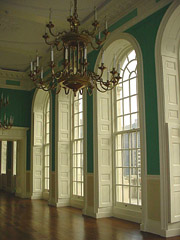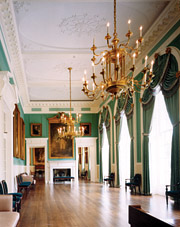
The architectural and engineering firm of Vollmer Associates, and electrical and mechanical specialists, Lakhani & Jordan Engineers, undertook this complex challenge by designing a modern air conditioning system in the historic Governor's Suite in New York's City Hall (NYCH). The architectural design needed to preserve the historic distinction of rooms and building, while installing state-of-the-art technology.
Located in downtown Manhattan, NYCH was built at a construction cost of $496,634 and was dedicated on July 4, 1811. In 1858, much of the upper stories and the cupola were destroyed in a fire touched off by a fireworks display that celebrated the completion of the Atlantic Cable. The building was restored two years later, and the façade was completely rebuilt from 1954 to 1956. It was declared a New York City landmark on February 1, 1966.
The Governor's Suite on the second floor consists of three connected drawing rooms that, at the start of the project, lacked both heating and air conditioning. The suite originally contained radiators enclosed in wood covers in the east and west wings and no heating in the middle chamber. There never had been any ventilation or air conditioning.
The suite had served chiefly as a museum of decorative arts, many by John Trumbull, and a reception room. On its walls hung numerous valuable portraits, and its antique furnishings included a desk that was used by George Washington when he was president.
To protect the furnishings and the paintings, the New York City Department of Citywide Administrative Services, the Office of the Mayor, and the New York City Art Commission initiated a project to control the fluctuation of temperatures in the suite. There was to be no visible change in the interior. All piping, ducts, and diffusers were to be located to minimize any visual impact to the public rooms and offices. This was particularly challenging because the solid masonry structure of the building provided virtually no voids in which to run piping or ducts.
Obstacles and Solutions
Initial attempts to find room to run the pipes proved futile. A probe was conducted adjacent to a window frame to see if there was any space behind the wood casing to run pipes, but none was found. The walls that flanked the Governor's Suite were 3-ft thick.Another probe was made of the area in the west attic, where it was believed a flue might be located. A camera was snaked into a hole and through a series of bends, which ended up in the fireplace in the east room of the Governor's Suite, suggesting one possibility for routing at least some of the ductwork. The ceiling offered another possibility. It was discovered that the ceilings in the east and west rooms were slightly lower than the ceiling in the central room, which meant that the floor of the attic above was below the central room's ceiling. However, the attic had large, heavy timber knee braces that would impede the installation of AHUs.
Solutions were fashioned to overcome the obstacles and existing conditions. Two AHUs were installed - one in the east attic and one in the west. Ductwork was installed through the attics for supply and return air. Finally, the existing radiators were replaced with two-pipe fancoil units to provide heating and air conditioning. The fancoil units would conform to the exact interior shape hidden by the existing radiator covers.
Though otherwise sound, the solutions introduced new challenges, particularly, how to run pipes, conduits, and ducts without creating a visible change to the room.
New Problems Resolved
Slim linear openings were installed above the high ceiling cornice of the central chamber for both supply and return air. The cornice projection hid the openings from view, leaving behind a fine shadow line. Supply diffusers, 3 in. high and 3 ft long, were placed above the north wall ceiling cornice of the suite, and 1-in.-high, 3.5-ft-long return registers were located above the east and west walls ceiling cornice of the central chamber.The supply ducts ran from the AHUs in the two attics into a crawl space adjacent to the Governor's Suite then into a plenum behind the ceiling cornice, which led to the 3-in.-high linear diffusers. Flexible aluminum ducts snaked the curvy fireplace flues to return air from all three chambers.
The return air ducts ran from the central 1-in.-high diffusers directly back to the east and west attic AHUs. The smaller registers were used in the east-west axis because the room is longer in this direction and the bigger diffusers would have been more visible. The north-south axis of the room is shorter so that diffusers as high as 3 in. were not visible from below. That resolved the issue and supply and return air to the central chambers. For the east and west rooms, flexible ducts were run from the attic through both the chimneys and ended in the abandoned fireplaces in both rooms.
Chilled and hot water piping for the fancoil units were brought down from the two attics through new chases in the stairwell walls on both sides of the Governor's Suite. It penetrated the 3-ft rubble wall of the east and west rooms below their existing floor into the floor joists on its way to the six fancoil units. The condensate drain pipes then ran vertically down through the office rooms below in newly created chases to the basement and emptied into window areaways below the exterior floor grates.

Attention to Aesthetics
All visible changes to NYCH had to be approved by the art commission, which is located on the third floor directly above the Governor's Suite. Photorealistic renderings were created for every scenario depicting before and after conditions in order to obtain the necessary approvals.The chases that were created in the stairwells and first floor offices were required to be aesthetically pleasing and blend with the historic fabric of the building, giving the appearance that they had always been there.
Openings in the 3-ft rubble walls of the two stairwells were about 9 in. high and 48 in. long. Masonry was carefully removed in 1-ft sections. A 1-by-36-in. steel plate was inserted with a 4-in. temporary steel support pipe. This was done four times. Then 8- by 8- by .75-in. steel lintels were placed on both sides and the temporary supports were removed, allowing pipes and conduits to enter the suite.
Once the pipes entered, they had to pass through perpendicular floor joists to reach the fancoil units. The joists were notched to accommodate the pipes' passage and reinforced with 3/8-in. steel plates. The floorboards were reinstalled and refinished.
The existing radiator covers were removed and replaced with new fancoil units that were custom built to follow the location of the slots in the original covers. New covers were custom built that exactly replaced the original covers.
With this intersection of the new HVAC system complete, NYCH continued with the restoration of the Governor's Suite and its furnishings, painting in a color matching its original French green, reupholstering the chairs with a wool plush fabric, and creating a curtain design that also reflected the original window treatments. The room now evokes three distinct periods: early 19th-century furnishing, finishes, and portraits; early 20th-century architecture; and an early 21st-century HVAC system that can be enjoyed without being seen. ES
